I was disappointed when land was cleared and the area near the entrance was torn up. Over the months an old maintenance shed was demolished and a pavilion was constructed. It included an elevated walkway which provided views of birds at tree-top level. Trails were improved and paved, exotic vegetation removed and butterfly-friendly shrubs were planted. Schoolchildren now attend organized walks and educational programs. The old pond and marshy area are traversed by a new boardwalk which also leads to the river's edge.
This image was taken last October and shows the curving fenced walkway:
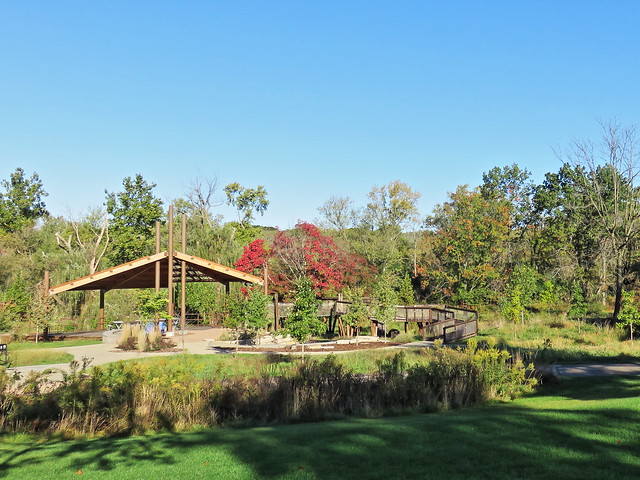
During a break in the rainy weather this past week Mary Lou and I visited Lippold park. Here are a couple of views of the pond and boardwalk:
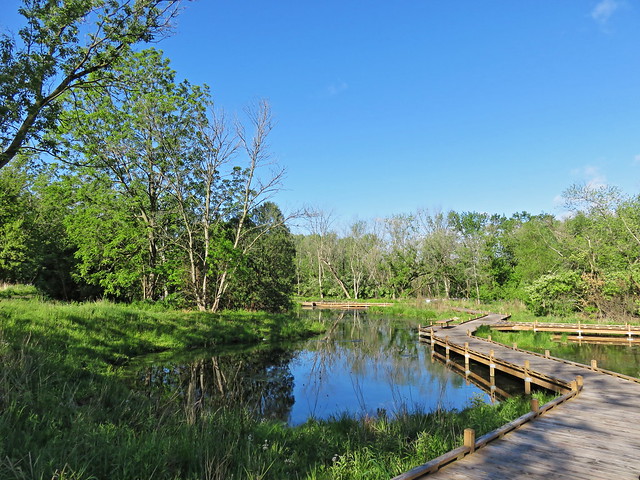
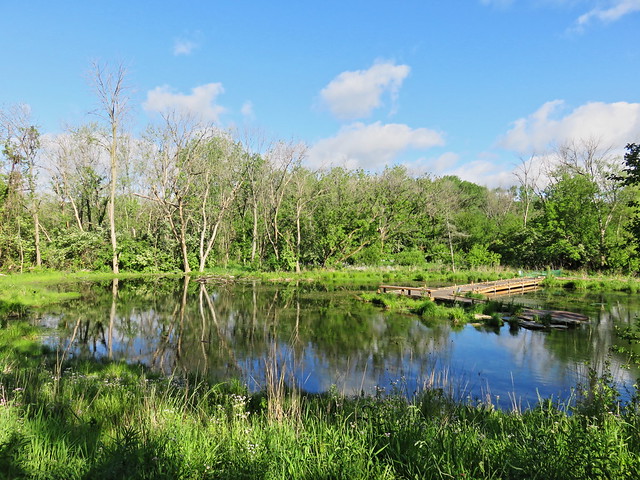
In the fall, Purple Finches visited the cones of one of the tall Bald-cypress trees near the river's edge:
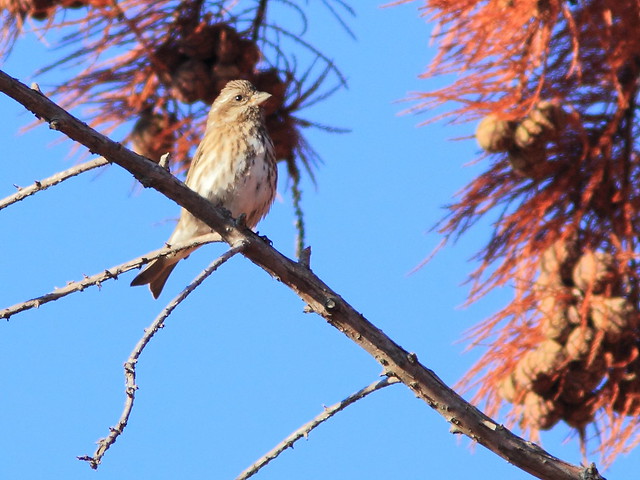
Unlike other conifers, the Bald-cypress trees lose their needles over the winter. Last week they were sprouting fresh green foliage and emerging green cones.
We were surprised to find a small flock of Cedar Waxwings (Bombycilla cedrorum) moving through the green branches of one of the cedars. At first I thought they were finding insects, but then noticed that they were examining the tiny cones...
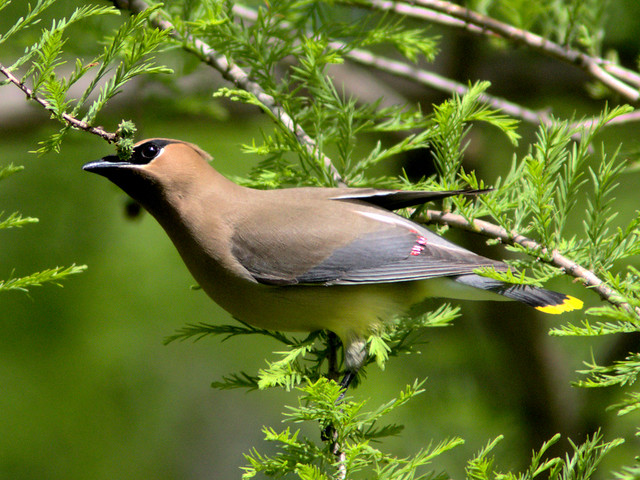
...and plucking them!
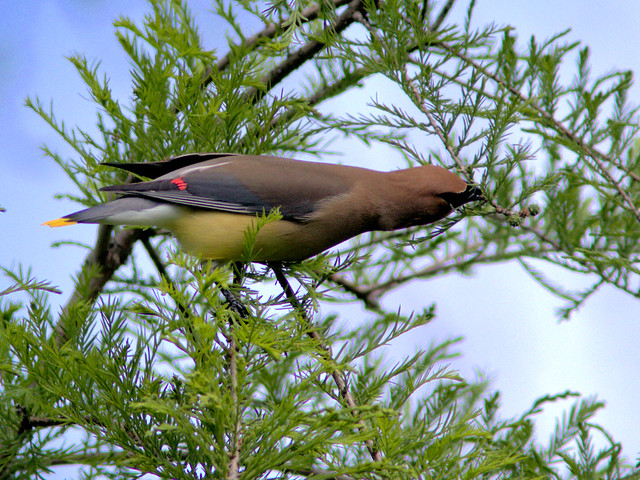
Their actions were acrobatic as they gathered cone buds from the tips of the branches:
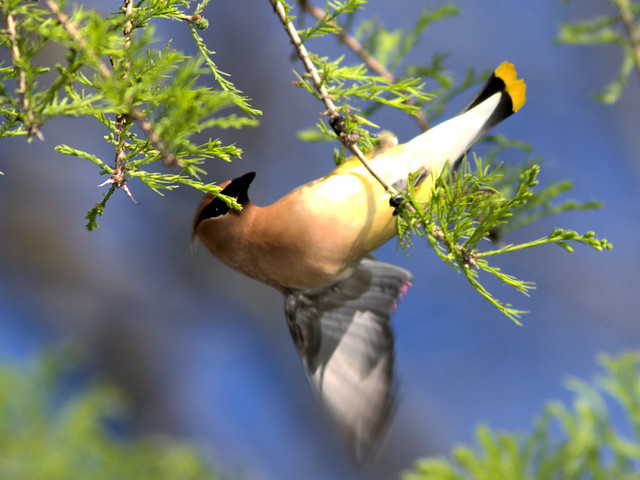
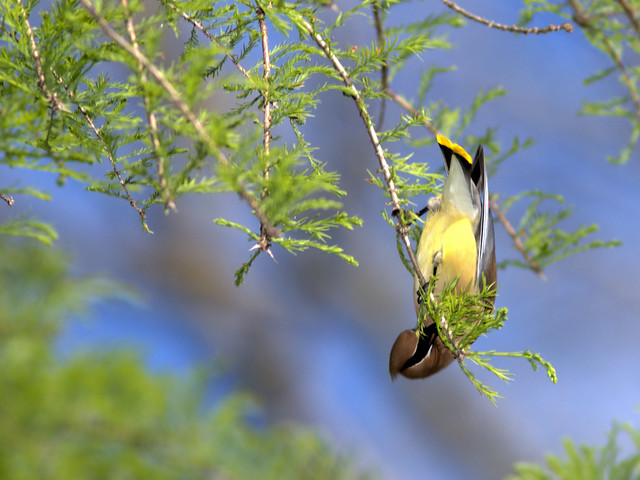
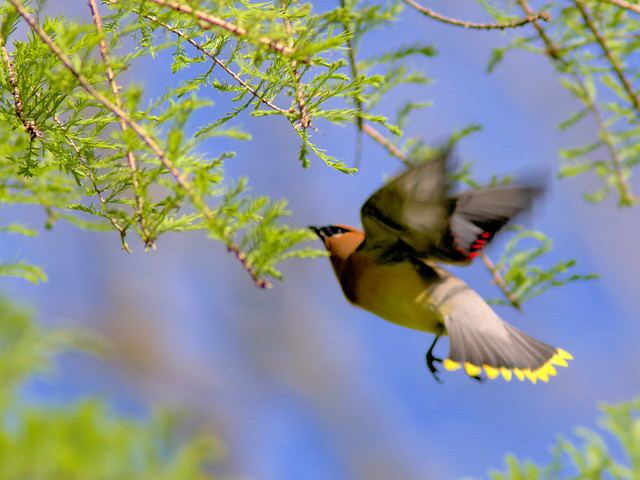
Cedar Waxwings are one of only three members of a family which includes the Bohemian and Japanese Waxwings. The latter is an Asian species and the Bohemian breeds in the far northwestern reaches of Canada into Alaska.
Cedar Waxwings breed all across the northern tier of the US and in southern Canada. They winter south into all of the US, Mexico and Central America. Northernmost birds probably take the place of others which migrate to the south, but their presence can be quite irregular. In Florida we may see large flocks one winter and none at all for most of the next.
Back in Florida, a flock of over 50 Cedar Waxwings seemed to have perfectly synchronized wing-beats (February, 2010):
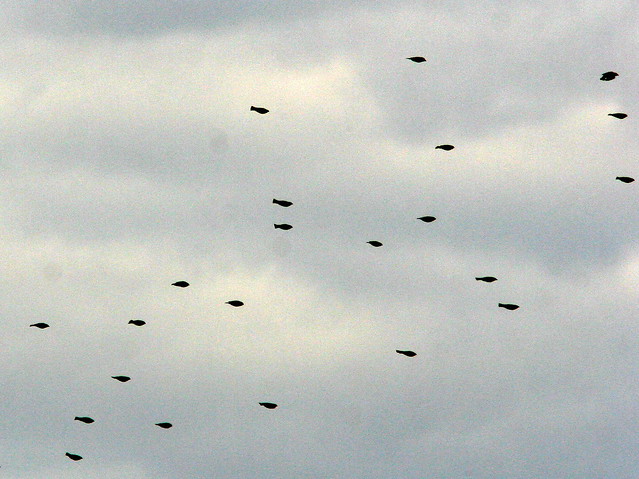
Waxwings get their names from distinctive red wax-like tips on the bare ends their secondary flight feathers. Their diet mainly includes berries, fruit and tree buds, but also many insects. Often they may be seen high in the sky, hawking flying insects in flocks along with swallows. Their habit of eating juniper ("cedar") berries during the winter earned the Cedar Waxwings their first names.
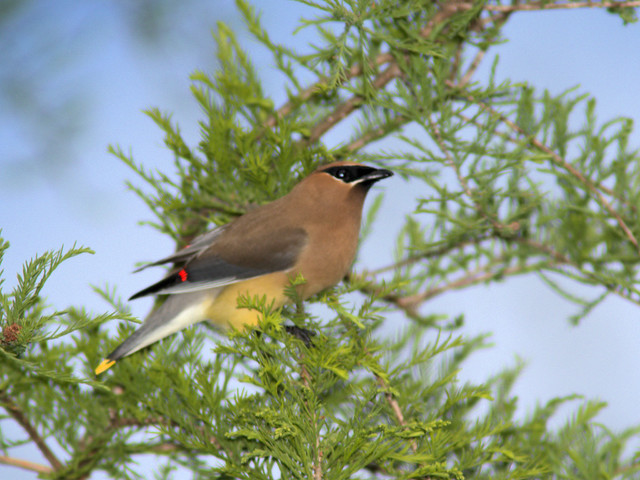
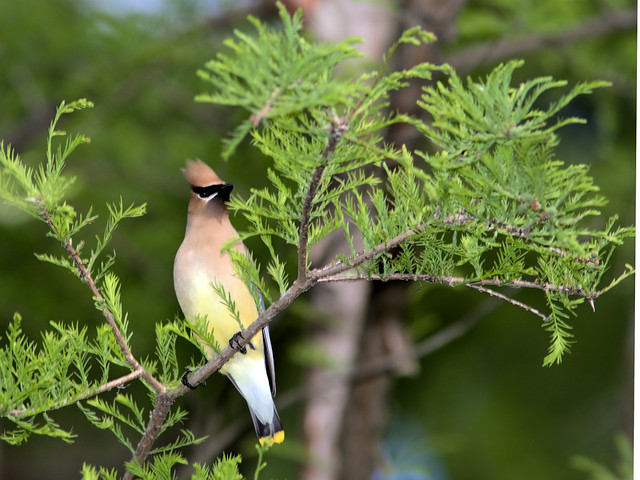
Here are two of my favorite images of the species, both taken at Lippold Park, in May, 2009...
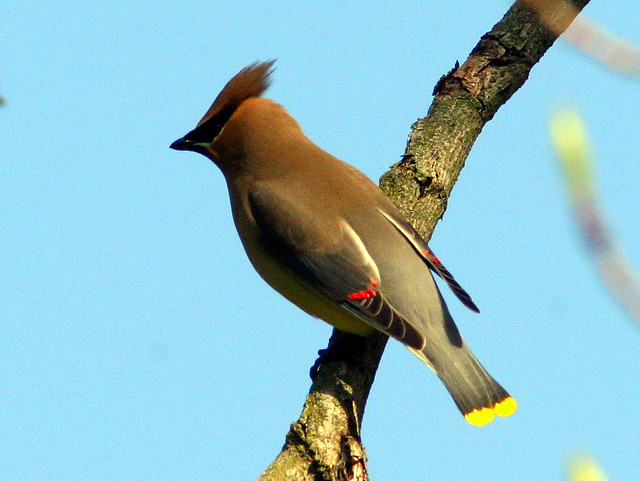
...and in September, 2011:
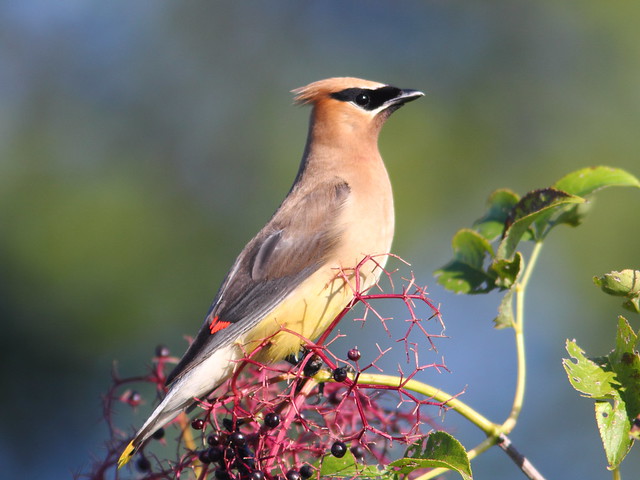
= = = = = = = = = = = = = = =
Linking to Misty's CAMERA CRITTERS,
Linking to Eileen's SATURDAY'S CRITTERS,
Linking to FENCES AROUND THE WORLD by Gosia
Linking to WEEKEND REFLECTIONS by James
Linking to BirdD'Pot by Anni
Linking to Wild Bird Wednesday by Stewart
Linking to Wordless Wednesday (on Tuesday) by NC Sue
Linking to ALL SEASONS by Jesh
________________________________________________
Please visit the links to all these memes to see some excellent photos on display
________________________________________________
ahhh, enjoyed
ReplyDeleteAn absolutely gorgeous series of photos, Kenneth! Thank you so much for sharing your amazing photographic talent.
ReplyDeleteOh, Mr. Kenneth, your pictures are fantastic, perfect. The birds are beautiful. What a variety of wonderful birds you have in your paradise.
ReplyDeleteCongratulations.
Magnificent photography of the beautiful birds ~ what a lovely place ~ thanks,
ReplyDeleteHappy Weekend ahead to you ~ ^_^
I love that boardwalk! The waxwing shots are wonderful... I like the variety!
ReplyDeleteLove your bird images, so sharp and clear. I love birds and it's such a pleasure to see those that we don't have here.
ReplyDeleteHi Kenneth, really interesting article, we get Waxwings in the UK but only as a winter visitor from the Scandinavian countries, and even then it depends on how harsh the winter is over there. If they are having a good winter and there is plenty of food, then we don't get many. If they are having a bad winter, then we may get what we call an influx year. The species we get is Bombycilla garrulus.
ReplyDeleteCheers Gordon.
WOW! Those wagwings are so beautiful and those 2 shots that you like are fabulous Kenneth. Love all the reflections in the water. Have a wonderful weekend.
ReplyDeleteWhat a beautiful bird!!! Never seen ans that makes this bird very special for me.
ReplyDeleteBeautiful pictures, especially the photos of the birds.
ReplyDeleteWonderful images of the Cedar Waxwings!
ReplyDeleteI saw some here in north Mississippi several years ago, and I keep looking for them to be here again, but no luck yet.
Have a wonderful week-end!
Hello wonderful captures of the Cedar Waxwings. They are beautiful birds. Thank you for linking up and sharing your post. Happy Saturday, enjoy your weekend!
ReplyDeleteIt is a beautiful park and you have spotted lovely birds.
ReplyDeleteThose are wonderful pictures of an all-time favorite of mine; one of my spark-birds! I was told by someone who seemed to know what she was talking about that Cedar Waxwings don't follow a set migration path, one of the few species that do not. This kind of goes along with what you are saying here. Thank you for the beauty and memories. (I haven't seen any in Florida, but did see some last summer in Oregon.)
ReplyDeleteReally enjoyed seeing the photos of the park and the Cedar Waxwings. A passing flock stopped on my deck earlier this year. I really hope they'll stop back by sometime. I enjoyed your amazing photos of such beautiful birds.
ReplyDeleteWhat a nice walkway to really get out on the land where trails would be difficult. Of course it's neat to see the Cedar Waxwings. They pass through this part of FL in the winter but only stay a day or two. So you have to be lucky to even spot them. Enjoy your holiday weekend!
ReplyDeleteHello Ken!:) Absolutely gorgeous captures of the beautiful Cedar Waxwings. What a stunner!!
ReplyDeleteYou managed to get some extraordinary 'action' shots of the waxwings!! They're beautiful, aren't they?
ReplyDeletePretty park!
Before I leave, I want to send along my thanks for linking in at I'd Rather B Birdin' to share this post with us!!
In some ways it's nice to see bits of improvement, but when they tear down the very things they are supposed to preserve it rather bothers me.
ReplyDeleteGreat birds - I ticked waxwings in the UK from a bus! I got off at the next stop and walked back for a better look - I ended up late for work! Good times.
ReplyDeleteCheers - Stewart M - Melbourne
So much enjoyed seeing your photos of the Cedar Waxwings in Illinois. Batavia is not far from Aurora where I grew up! This spring I saw a small flock of these birds in my area in Texas. Had never seen them before and enjoyed the photos that I was able to get. thanks for sharing the beauty of illinois
ReplyDeleteSuperb reflections!
ReplyDeleteWhat beautiful pictures.... a lovely place. :)
ReplyDeleteBeautiful pictures and interesting info about the cedar waxwings. One year I had a group of them visit my cherry tree but I haven't seen them since. Love your last picture, cedar waxwing & elderberry bush.
ReplyDeleteThe cedar Wazwing is such a pretty and distinctive bird I love the yellow tip of their tail! You must have been watching for some time to be able to figure out it was plucking the pinecones:) Many thanks for sharing their acrobatic acts with All Seasons!
ReplyDeleteCouldn't figure out if you like the improvement at Lippold park of not? In any case have a great week!
This bird is so gorgeous! It looks very classy and your shots are terrific.
ReplyDeleteA wonderful place to visit and the birds are beautiful.
ReplyDeleteAmalia
xo
I always enjoy so much your very beautiful images!
ReplyDeleteLovely birds.
Some great improvements! And I love your cedar waxwing photos. Such wonderful tips of yellow on the tail and red on the wings as though it had visited a plein air artists pallete for a moment before flying off!
ReplyDeleteExceptional captures, Kenneth! These masked-bandits are one of my favorite birds. Your post was a treat!
ReplyDelete